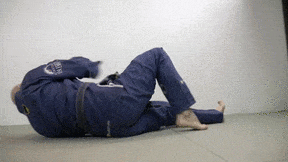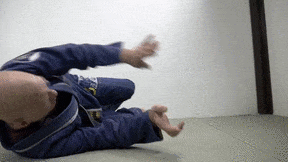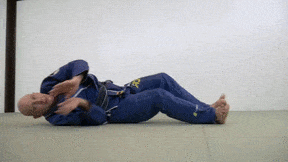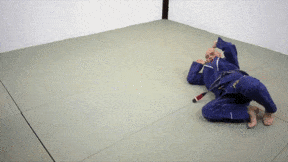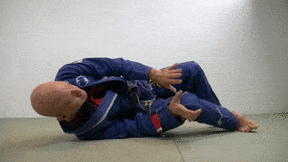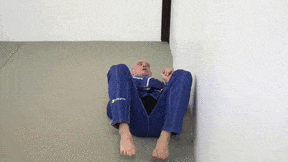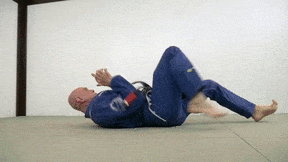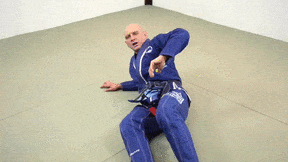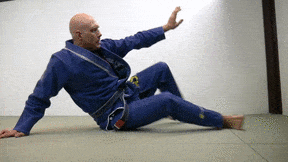Everyone says that moving your hips is one of the keys to jiu-jitsu. And they’re absolutely right: the correct movement of the hips is critical not only for escaping bad positions, but also for applying submissions, sweeping your opponent, passing the guard and much more.
Traditionally an exercise called ‘shrimping’ is often used in Brazilian Jiu-Jitsu to develop hip movement.
This exercise originally came from Judo where it is known as ‘ebi’ which, not-so-coincidentally, is the Japanese name for ‘shrimp’.
Most people only know one or two ways to shrimp, but there are many more methods, all of which develop your hips moment and overall body coordination in different ways.
10 Ways to Shrimp and Improve Hip Mobility on the Ground – The Video
In the embedded Youtube video below I’ll show you 10 different ways to shrimp…
…or you can scroll down below the video to get the same shrimping methods broken down for you with text and animated gifs.
BASIC SHRIMPING METHOD 1: THE TWO LEGGED SHRIMP
(Covered in my Youtube video from c. 0:23 to 1:16)
This is the most basic way to learn how to shrimp. Start here first because it’s the foundation for all the other exercises we’ll do today!
In this exercise you’re learning how to coordinate your feet, your hips and your shoulders to move your body backwards across the mat.
It’s absolutely one of the most important movements in all of jiu-jitsu.
Here are the steps to do the basic shrimp…
- Lie flat on your back with your feet out straight and your hands up
- Roll so that you’re slightly on one side
- Bring both feet up to your butt
- Lift your hips off the ground and move your hips back towards your head while piking your body forward
- Straighten your body out and repeat on the other side
A common mistake with this form of shrimping is keeping your body flat on the ground; this results in far too much friction between you and the mat, making it very difficult to move fast and efficiently.
Instead focus on turning your body to one side, and getting your hips OFF the floor while you’re actually shrimping backwards. An analogy I often use when teaching this movement is to make sure that you could slide a piece of paper under your hips…
BASIC SHRIMPING METHOD 2: THE ONE LEGGED SHRIMP
(Covered in my Youtube shrimping video from c. 1:16 to 2:16)
The one legged shrimp is similar to the first method (the two legged shrimp) but applicable to slightly different situations.
Among other things it simulates the motion of escaping from mount or sidemount where one leg posts on the floor and the other leg – your trailing leg – manoeuvres into position and re-establishes the guard.
Plus it’s pretty fast; go with this style in a shrimping race and you’ll blow the doors off of anyone using the first method.
Here are the steps to do the one-legged shrimp…
- Lie flat on your back with your feet out straight and your hands up
- Roll so that you’re slightly on one side
- Bring one of your feet up to your butt
- Lift your hips off the ground and move your hips back towards your head while piking your body forward and dragging the non-posting leg along the floor
- Straighten your body out and repeat on the other side
Common mistakes include turning towards the side you’ve posted your leg on. For example if you post your right leg then you should turn towards your left side.
If instead you turn towards your posting leg you’ll end up all screwed up and the movement won’t work.
BASIC SHRIMPING METHOD 3: SIDEWAYS SHRIMPING
(Covered in my Youtube shrimping video from c. 2:17 to 3:07)
The sideways shrimping method looks a lot like you’re wriggling out of side control: you’re inching backwards in a two-step motion.
You don’t cover as much ground in this movement as you do with the first two drills, but it’s still a really important motion to master.
Also unlike the previous two methods (where you alternate right and left sides) for this drill you’re always facing the same direction.
To do the sideways shrimping drill…
- Start on your side with hands up near your face
- Swing your feet and your shoulders backwards so that you’re arched with your hips pushing forward
- Put all your weight on your shoulders and your feet and then move your hips backwards so that you end up in a piked position
- Stay on the same side and repeat
BASIC SHRIMPING METHOD 4: FORWARD SHRIMPING
(Covered in my Youtube shrimping video from c. 3:07 to 4:15)
In the forward shrimping drill you move down towards your feet (unlike the the first two methods of shrimping where you moved in the direction that your head was pointing).
This motion resembles getting out of a north-south position, but it can also be used to escape armlocks, close the distance with your opponent, and many other applications.
Forward shrimping can be a little trickier than the first 3 methods, but if you follow the steps carefully you should be able to get it!
- Lie flat on your back, legs straight and your hands up
- Roll to one side and also crunch your shoulders down towards your waist
- Your weight should now be on your heels and one shoulder
- Pivot on your shoulder and pull with your heels to move your body towards your feet (you start in a slight pike position and end in a slight arch)
- Extend your legs, roll to the other side and repeat
SHRIMPING METHOD 5: BOX SHRIMPING
(Covered in my Youtube shrimping video from c. 4:15 to 5:59)
This method combines the first 4 types of shrimping in a single drill.
It ensures that you work all of your basic shrimps on both sides and is a great warmup drill once everyone understands how to do the four basic shrimping methods above…
- Backwards shrimping (one or two legged) from the front to the back of the mat
- Sideways shrimping from one side of the mat to the other
- Forwards shrimping from the back to the front of the mat
- Sideways shrimping across the mat in the opposite direction as before
- Repeat the box pattern as often as desired
SHRIMPING METHOD 6: BRIDGE AND SHRIMP
(Covered in my Youtube shrimping video from c. 5:59 to 6:50)
Sometimes you can’t just shrimp your way out of situation, you need to create some space first.
The bridge is one of the most powerful tools in your arsenal for creating space. It bumps your opponent up and gives you a split second to move without his full weight resting on you.
But you’ve got to be quick to take advantage of that limited time frame, which is where this drill comes in!
The bridge and shrimp drill combines two important movement – basic two legged shrimping and basic two legged bridging – performed in close succession…
- Start flat on your back with your legs extended
- Bring your feet to your butt, the balls of your feet on the floor and the heels elevated
- Bridge your hips up high, still on the balls of your feet
- Turn sideways in mid-air and perform a two legged shrimping movement
- Straighten out your body and repeat on the other side
SHRIMPING METHOD 7: SIDE CONTROL WALL SHRIMP
(Covered in my Youtube shrimping video from c. 6:50 to 8:47)
The wall shrimp is super-useful for learning how to put someone back into the guard when you’re on the bottom of sidemount.
It teaches you the importance of shoving your opponent away from you sideways and creating room with a bridge before trying to bring your legs back between your opponent and yourself.
(This idea of sometimes bridging horizontally rather than always bridging up and down is an eye-opener for many BJJ students.)
Plus you can’t move a wall, so this drill also teaches you to move yourself rather than your opponent when you’re putting someone back into the guard. This is a very useful skill to develop for when you’re fighting someone much bigger than you!
To do the side control wall shrimp…
- Lie down parallel to a wall and a few inches away from it. Your feet are near your butt and your hands are up
- Bridge up and towards the wall; the goal is to touch your belly button on the wall
- Shrimp backwards so your hips drop down to the floor a good distance away from the wall
- Bring your near leg up against the wall with your entire shin against the wall about 1 foot off the floor
- Use that knee and shin on the wall to spin your whole body into position and bring both feet up so they’re touching the wall
- Repeat on the other side
SHRIMPING METHOD 8: SHRIMP AND TURN OUT
(Covered in my Youtube shrimping video from c. 8:47 to 9:59)
The shrimp and turn out motion simulates, among other things, being on the bottom of sidemount, turning in towards your opponent, and then securing a single leg or coming to base.
The same motion can also be used in a scramble to set up your wrestling takedowns.
To do the shrimp and turn out drill…
- Start in the one legged shrimping position (slightly on your side, one leg up, the other leg straight)
- Begin the regular shrimping motion, but your trailing leg comes underneath your posting leg
- End up in a tripod position, posting on one shoulder and both feet
- Reverse directions, step back through, end up flat on your back again
- Repeat on the other side
SHRIMPING METHOD 9: ELBOW SHRIMP
(Covered in my Youtube shrimping video from c. 10:00 to 11:23)
These next two drills are critical for incredibly useful for developing the’frame and hip escape’ method of guard retention (this method explored more fully in the Two Most Important Guard Retention Techniques article on my site).
The elbow shrimp is one of my very favourite movements to stop my opponent from passing my guard. But you can also use the exact same movement to escape from wide variety of pins and bad positions.
This motion is exactly the same movement as the basic shrimp we covered at the top of this article except for the fact that you’re not on your side on the ground.
In the elbow shrimp you’re sitting up with your body inclined at roughly a 45 degree angle and resting on one elbow. However your hips move backwards exactly as in the basic two legged shrimping method.
Here’s how to do the elbow shrimp…
- Start sitting on your butt
- Lie back onto one elbow and lift the other arm, simulating keeping your opponent at a distance
- Your other arm is maintains a farm
- Bring your feet in as close to your butt as possible, knees pointing roughly 45 degrees to one sidePivoting on your arm and feet escape your hips backwards, ending up in a butterfly guard position
- Repeat on the other side
SHRIMPING METHOD 10: HAND SHRIMP
(Covered in my Youtube shrimping video from c. 11:34 to 12:45)
This is very similar to method 9 except you’re going to create an even bigger movement by coming up onto your hand instead of your elbow. This bigger motion
It is used in a very similar way to the elbow shrimp both to prevent the guard pass and also to escape bad positions.
Here’s how to do the hand shrimp…
- Sit on your butt and place your hand on the mat a few feet behind you (your arm is roughly at a 45 degree angle)
- Your other arm stretches forwards to guage and maintain the distance.
- Bring your feet in as close to your butt as possible, knees pointing roughly 45 degrees to one side
- Pivoting on your arm and feet escape your hips backwards, ending up in a butterfly guard position
- Repeat on the other side
The Next Step

If you enjoyed this article and found it useful I have one more suggestion for you, and that’s to sign up for my email newsletter.
Now it’s true that most newsletters absolutely suck – they give you nothing of value and only ever try to sell you stuff.
However that is definitely NOT the case with the Grapplearts newsletter! In those emails I send out a ton of valuable content, including tips, techniques, tricks and training methods.
Plus if you sign up you get to download a PDF of the Roadmap for BJJ, my guide to learning BJJ fast, entirely for free.
People really like these emails – in face every day I get quite a few messages from people telling me how much they’re enjoying the emails and how useful they’ve been for their training.
Finally, if you don’t like what I send you there’s a link at the bottom of each and every email saying ‘manage your subscription’. Click on that link and you can easily unsubscribe with just one more click.
Enter your email below and then look for the confirmation email with the PDF download link which I’ll send you right away…
More Guard Retention…
The guard is the most important position in BJJ, and having good guard retention may be the single-most important skill in the art.
If you’re interested in learning more about shutting down your opponent’s guard passes then I highly recommend The Guard Retention Formula instructional.
Click here for more information about The Guard Retention Formula, the detailed instructional on how you can make it really, really difficult for your opponent to pass your guard and give you the confidence to attack from the bottom knowing that you can recover no matter what happens.
The post The Ultimate Guide to Developing BJJ Hip Movement Through Shrimping appeared first on Grapplearts.


